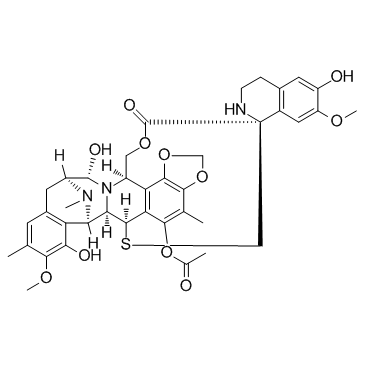| References: |
Trabectedin (Ecteinascidin-743 or ET-743) is a novel antitumour agent of marine origin with potent antitumour activity both in vitro and in vivo. IC50 Value: 0.1-3.7 nM (breast cancer cell lines) Target: Apoptosis inducer; Anticancer in vitro: Trabectedin induced cytotoxicity and apoptosis in both breast cancer cells in a time and concentration-dependent manner. The expression levels of the death receptor pathway molecules, TRAIL-R1/DR4, TRAIL-R2/DR5, FAS/TNFRSF6, TNF RI/TNFRSF1A, and FADD were significantly increased by 2.6-, 3.1-, 1.7-, 11.2- and 4.0-fold by trabectedin treatment in MCF-7 cells. However, in MDA-MB-453 cells, the mitochondrial pathway related pro-apoptotic proteins Bax, Bad, Cytochrome c, Smac/DIABLO, and Cleaved Caspase-3 expressions were induced by 4.2-, 3.6-, 4.8-, 4.5-, and 4.4-fold, and the expression levels of anti-apoptotic proteins Bcl-2 and Bcl-XL were reduced by 4.8- and 5.2-fold in MDA-MB-453 cells . In vitro treatment with noncytotoxic concentrations of trabectedin selectively inhibited the production of CCL2, CXCL8, IL-6, VEGF, and PTX3 by MLS primary tumor cultures and/or cell lines . in vivo: A xenograft mouse model of human MLS showed marked reduction of CCL2, CXCL8, CD68+ infiltrating macrophages, CD31+ tumor vessels, and partial decrease of PTX3 after trabectedin treatment . The MTD of trabectedin was 700 microg/m(2) due to dose-limiting neutropaenia and the RDs in the previously treated/untreated patients were 500 and 600 microg/m(2), respectively. Most common toxicities were nausea/vomiting (67%), asthenia/fatigue (55%) and reversible ASAT/ALAT elevation (51%) . Toxicity: Most common toxicities were nausea/vomiting (67%), asthenia/fatigue (55%) and reversible ASAT/ALAT elevation (51%) . Clinical trial: A Study to Assess the Potential Effects of Rifampin on the Pharmacokinetics of Trabectedin in Patients With Advanced Malignancies. |























